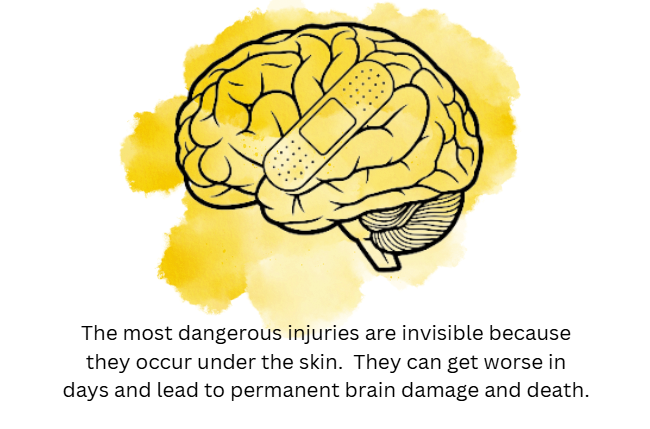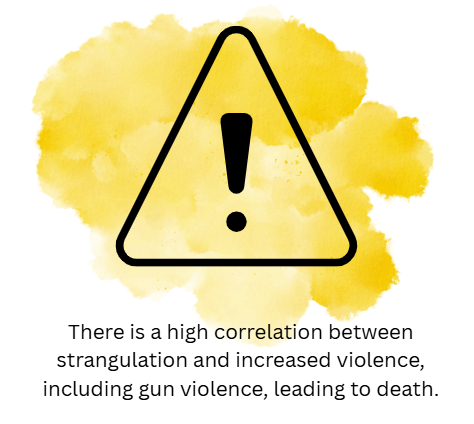IPV Related Head/Neck Injuries
Sports injuries or car accidents often cause head injuries. However, research shows up to 94% of injuries sustained due to intimate partner violence are to the neck or head. Additionally, over 75% of survivors suffer single or repeated traumatic brain injuries, most of which go unreported1. No one should ever hit, slap, punch, strangle, or suffocate you. Even in the course of consensual acts, these actions could have serious short and long term consequences.

Head Injuries
A head injury is when there is a change to how your brain normally works due to a bump, blow, or jolt to your head, or when your brain does not get the oxygen or blood it needs, like when someone chokes you or does something that messes with your breathing. Sometimes the change is temporary and sometimes it lasts longer.
People who commit interpersonal violence target the head, neck, and face more than anywhere else on the body. They might hit the face or head, put their hands around the neck to choke or strangle, cause the person to fall and hit their head, or restrict air flow by putting a hand over the nose or mouth.
- Concussions
- Traumatic brain injuries
- Bruising
- Loss of consciousness
- Fractures
- Headaches
- Seizures
- Swallowing issues
- Severe head and neck injuries can be serious, life threatening, and at times fatal
- Loss of breath or difficulty breathing
- Loss of consciousness
- Memory loss
- Dizziness, nausea, headache, or disorientation during or after the incident
- Vision loss or vision changes
- Hearing loss or hearing changes
- Voice changes or difficulty speaking
- Coughing or difficulty swallowing or sensation of something in the throat
- Sore throat
- Involuntary urination or defecation during the incident (typically indicates loss of consciousness)
- Problems with balance or coordination
- Pain or stiffness to the neck
- Petechiae (small, pinpoint-sized red or purple spots that appear on the skin due to bleeding under the surface and are caused by the rupture of tiny blood vessels, known as capillaries)
If you are experiencing any of the warning signs above and the incident occurred within the last 14 days, we strongly encourage you to seek medical attention. You can schedule a confidential consultation with Deacon Health by scheduling an appointment via the Deacon Health Portal or by calling 336.758.5218.
We encourage you to keep a log of symptoms including the date and time of occurrence, symptom, how often it’s occurring, severity (on a scale of 1-10), and any notes. This will help you see if your symptoms are getting worse.
If the incident happened more than 14 days ago, we still encourage you to follow up with a medical professional for consultation.
To help you feel supported, you can always ask for an advocate to join you at medical appointments for IPV related head or neck injuries. Call us 24/7 at 336.758.5285.
There are many resources on campus to support you as you heal from an IPV related head or neck injury. The Safe Office is here to explain options, connect you to resources, and help you navigate systems while you’re on your healing journey.
- Medical needs – Deacon Health
- Reporting options – Title IX, Student Conduct, University Police
- Academic needs- Office of Academic Advising (OAA), Center for Learning, Access, and Student Success
- Housing needs-RL&H
- Spiritual Support- Office of the Chaplain
- ….and many more. Each student is unique, and each student will have unique needs to be addressed throughout healing.

Need to leave the website quickly?
Safe Office
Need immediate assistance?
24/7 Confidential Support Line
Have a non-urgent question?
Visit Us!
Wake Safe App

Strangulation is a head injury and hurts your brain

- Even if you don’t have marks…
- Even if you didn’t pass out…
- Even if you don’t feel like it’s a big deal…
- Even if you feel it was consensual, strangulation can still be harmful and dangerous
Strangulation Myths
Click each of the below to learn about common myths about strangulation
Choking and strangulation are the same thing
Myth – “Choking” refers to a physical obstruction of the windpipe (e.g. food) resulting in a blockage that prevents the normal flow of air. “Strangulation” is often an intentional form of abuse due to external pressure applied to the neck. However, people often use the terms interchangeably when describing an incident.
Strangulation isn’t dangerous if it’s done consensually
Myth – If engaging in sex and strangulation, consent must be present and verbally communicated and agreed upon before, there are still risks associated. A person can go unconscious in seconds and die in minutes, or even days, after being strangled.
Strangulation is only dangerous if it leaves marks
Myth – Only approximately 50% of strangulation victims have visible injuries, even in severe or fatal cases.
Spencer, C. M., Keilholtz, B. M., Palmer, M., & Vail, S. L. (2024). Factors Associated with Non-Fatal Strangulation Victimization in Intimate Relationships: A Meta-Analysis. Trauma, Violence & Abuse, 25(3), 2103–2114. https://doi.org/10.1177/15248380231207874
Breath play during sex is different than strangulation
Myth – No matter what you call it…breath play, choking, sexual choking, erotic asphyxiation…they are all acts that restrict oxygen, respiration, and/or blood circulation, which can still be dangerous.
If you’re curious to understand more of the complexities of this topic, we recommend this article: Breathe: Risk, Realities, and Safer Alternatives to Choking and Breath Play
Strangulation isn’t something that college students are doing
Myth – Conte, Sharman, & Douglas (2025) found “recent studies on sexual choking/strangulation in Australia, the USA and Iceland identify sexual choking/strangulation as a rapidly growing trend among young adults”. They cite a survey of 4168 US undergraduate students where “26.5% of women, 6.6% of men and 22.3% of transgender and gender non-binary participants had been choked during their most recent sexual encounter.” They additionally found that this age range perceives strangulation to be less dangerous than it truly is.
Conte, I., Sharman, L.S. & Douglas, H. Choking/Strangulation During Sex: Understanding and Negotiating “Safety” Among 18-35 Year Old Australians. Arch Sex Behav 54, 483–494 (2025). https://doi.org/10.1007/s10508-025-03097-3
1: Valera, EM, Joseph, AC, ; Snedaker, et. al. Understanding Traumatic Brain Injury in Females: A State-of-the-Art Summary and Future Directions. Journal of Head Trauma Rehabilitation 36(1):p E1-E17, January 2021. | DOI: 10.1097/HTR.0000000000000652
Information on strangulation was sourced from the Ohio Domestic Violence Network- Center on Partner-Inflicted Brain Injury
